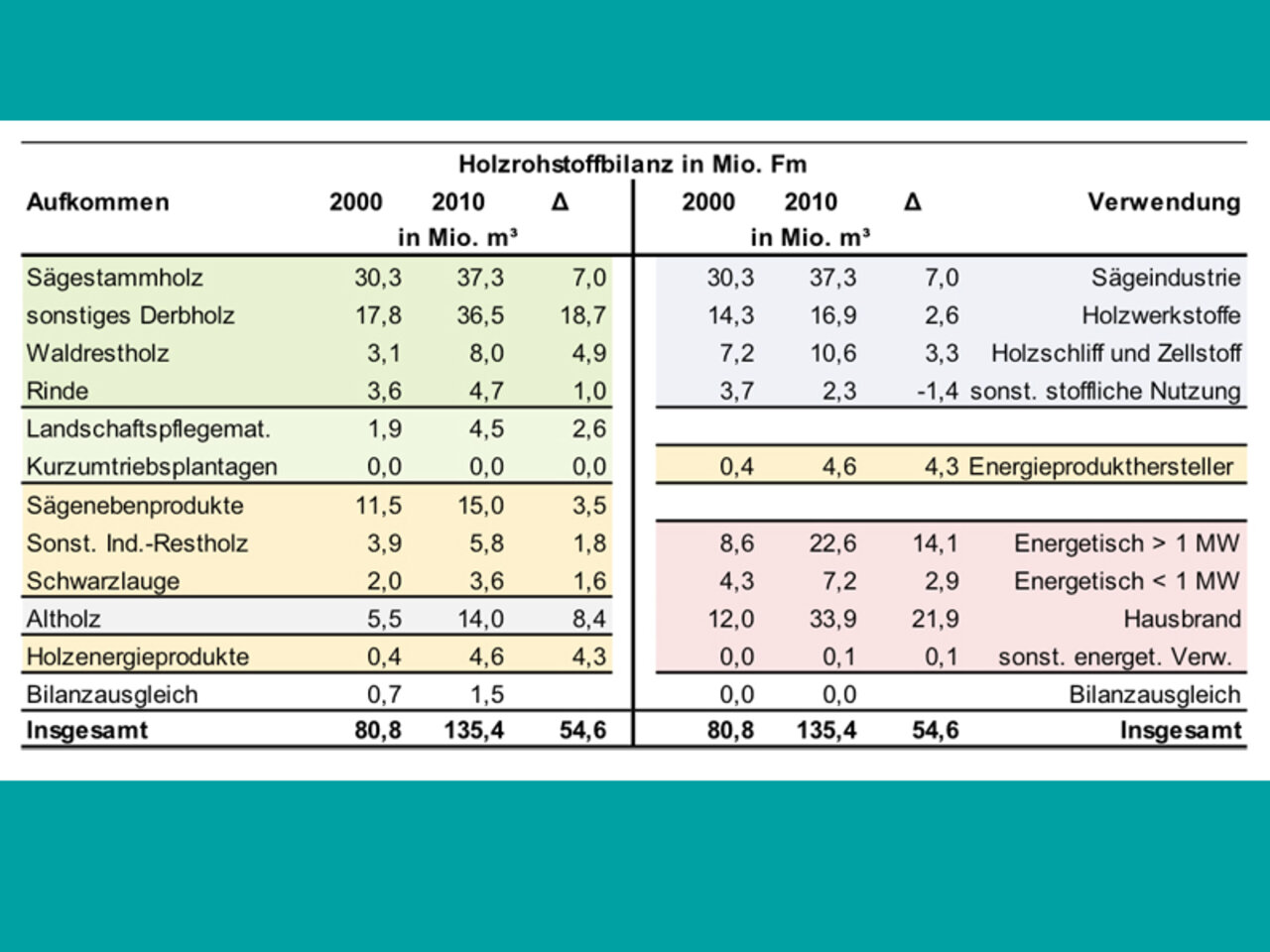Project
Resource monitoring for wood

Wood resource monitoring – material and energetic demand for wood
Wood is one of the most important renewable resources in Germany. But who uses this resource? How is the supply of the different assortments? Available statistics do show considerable gaps of information.
Background and Objective
In the year 1999 the project “location of the timber industry” was started. It is actually continued in a broader framework with the title “resource monitoring”. It aims at identifying production capacities and raw material demand of the wood processing industry in Germany ((saw mills, panel mills, pulp mills). Furthermore all other areas of the sources and the uses of the raw material of wood (recovered wood, urban wood, short rotation coppice (SRC), biomass power and heating plants, BTL, chemical raw material, private households) are monitored regularly.
The conducted surveys also allow the description of regional wood flows for most market segments. All resource flows are included in a wood raw material balance sheet, which meanwhile is calculated back to the year 1987.
Approach
As a basis separate analyses of the sectors of supply and use of the resource wood are conducted. Our methodology is as follows: We survey consumers regarding their use of the wood raw materials. The different mass flows are brought together in the wood resource balance. A specific focus is laid on sectors which not covered by official statistics (e. g. wood energy market, private households). But also in markets which are covered by statistics additional information is necessary, e. g. on the mix of wood raw material assortments or if only parts of the whole sector are covered (e. g. sawmills are only covered by official statistics when having at least ten employees).
Results
With regard to the storage of timber after extreme storm events, information on the storage behavior of a large number of forest enterprises over the period from 1991 to 2014 could be extracted on the basis of the Federal Forest Accountancy Data Network (FADN). In this time series, the two extreme storm events "Lothar" and "Kyril" occurred, which allowed a number of variables to be analyzed for their explanatory power towards timber storage. Specifically, these were the regional change in timber prices, the amount of damaged timber on enterprise level, the group of wood species, the type of ownership and the size class of the enterprises. Within the framework of a moderator analysis, a significant influence of the change in wood prices on the level of storage was found. In addition, a significant linear correlation between the amount of damaged timber and the amount of stored timber was determined in a multiple regression analysis. Also, significant differences between the categories of the corresponding variables could be found. State-forestry enterprises stored the highest quantities per hectare compared to private and municipal forestry operations. Coniferous species were stored to a much greater extent compared to deciduous tree species. Due to climate change and the resulting increase in the number of extreme storm events in the future, the economic investigation of timber storage is becoming increasingly important. In addition, the statistical models can contribute to better recording of the storage quantities and thus also to the fulfillment of national and international reporting obligations within the scope of the calculation of fellings.
With regard to the falsification of strategic response behavior in the sawmill industry, the results of the investigation indicate, in addition to the statistical cut-off threshold, further causes for under-reporting by the Federal Statistical Office. On the one hand, indications of a partly significant under-recording of production volumes by notifiable but not reporting enterprises were identified. On the other hand, lower quantities were reported to the statistical office with regard to their production volumes regarding the reporting enterprises. The combined analysis of all theoretically reportable enterprises showed an undercoverage of more than 50% for softwood and more than 40% for hardwood and more than 60% for planed softwood in the sample.
The calculation of fellings and removals could be carried out until 2017. The methodical procedure was revised in the course of the project. The results also show that official felling statistics continue to significantly underestimate actual felling quantities.
Links and Downloads
Thünen-Contact

Alumni
- Klaus Zimmermann
Involved external Thünen-Partners
-
Universität Hamburg
(Hamburg, Deutschland)
Publications
- 0
Zimmermann K, Döring P, Weimar H (2018) Analyse der Abweichung empirischer und amtlicher Meldungen zur Produktionsmenge von Schnittholz. Braunschweig: Johann Heinrich von Thünen-Institut, 20 p, Thünen Working Paper 87, DOI:10.3220/WP1519134675000
- 1
Zimmermann K, Schuetz T, Weimar H (2018) Analysis and modeling of timber storage accumulation after severe storm events in Germany. Eur J Forest Res 137(4):463-475, DOI:10.1007/s10342-018-1116-1
- 2
Döring P, Glasenapp S, Weimar H, Mantau U (2018) Rohstoffmonitoring Holz : die energetische Nutzung von Holz in Biomassefeuerungsanlagen unter 1 MW in Nichthaushalten im Jahr 2016 ; Teilbericht. Hamburg: Universität Hamburg, Zentrum Holzwirtschaft, 21 p
- 3
Döring P, Weimar H, Mantau U (2018) Rohstoffmonitoring Holz : Einsatz von Holz in Biomasse-Großfeuerungsanlagen 2016 ; Teilbericht. Hamburg: Universität Hamburg, Zentrum Holzwirtschaft, 23 p
- 4
Mantau U, Döring P, Weimar H, Glasenapp S, Jochem D, Zimmermann K (2018) Rohstoffmonitoring Holz : Erwartungen und Möglichkeiten [online]. Gülzow: Fachagentur Nachwachsende Rohstoffe, 32 p, zu finden in <https://mediathek.fnr.de/rohstoffmonitoring-holz-erwartungen-und-moeglichkeiten.html> [zitiert am 02.07.2018]
- 5
Mantau U, Döring P, Weimar H, Glasenapp S (2018) Rohstoffmonitoring Holz : mengenmäßige Erfassung und Bilanzierung der Holzverwendung in Deutschland [online]. Gülzow: Fachagentur Nachwachsende Rohstoffe, 161 p, SchrR Nachwachs Rohstoffe 38, zu finden in <https://mediathek.fnr.de/rohstoffmonitoring-holz-mengenmaessige-erfassung-und-bilanzierung-der-holzverwendung-in-deutschland.html> [zitiert am 02.07.2018]
- 6
Mantau U, Döring P, Weimar H, Glasenapp S, Jochem D, Zimmermann K (2018) Rohstoffmonitoring Holz: Daten und Botschaften [online]. Gülzow: Fachagentur Nachwachsende Rohstoffe, 8 p, zu finden in <https://mediathek.fnr.de/rohstoffmonitoring-holz-daten-und-botschaften.html> [zitiert am 04.07.2018]
- 7
Döring P, Glasenapp S, Mantau U (2017) Rohstoffmonitoring Holz : Holz- und Zellstoffindustrie 2015 ; Entwicklung der Produktionskapazität und Holzrohstoffnutzung ; Zwischenbericht ; Februar 2017. Hamburg: Universität, 17 p
- 8
Döring P, Glasenapp S, Mantau U (2017) Rohstoffmonitoring Holz : Holzwerkstoffindustrie 2015 ; Entwicklung der Produktionskapazität und Holzrohstoffnutzung ; Abschlussbericht ; März 2017. Hamburg: Universität, 24 p
- 9
Döring P, Glasenapp S, Mantau U (2017) Rohstoffmonitoring Holz : Sägeindustrie 2015 ; Einschnitt- und Produktionsvolumen ; Zwischenbericht. Hamburg: Universität, 32 p
- 10
Saal U, Weimar H, Mantau U (2017) Wood processing residues. Adv Biochem Engineering Biotech 166:27-41, DOI:10.1007/10_2016_69
- 11
Weimar H (2016) From empirical studies to bioenergy statistics: bridging the GAP of unrecorded wood-bioenergy in Germany. In: 9th International Scientific Conference : The path forward for wood products: A global perspective ; Baton Rouge, Louisiana, USA, October 5th - 8th 2016 . Baton Rouge: WoodEMA, pp 135-142
- 12
Döring P, Glasenapp S, Mantau U (2016) Rohstoffmonitoring Holz : Energieholzverwendung in privaten Haushalten 2014 ; Marktvolumen und verwendete Holzsortimente ; Abschlussbericht. Hamburg: Universität, 37 p
- 13
Mantau U (2012) Holzrohstoffbilanz Deutschland : Entwicklungen und Szenarien des Holzaufkommens und der Holzverwendung von 1987 bis 2015. Hamburg: Universität, 65 p
- 14
Mantau U, Weimar H, Kloock T (2012) Standorte der Holzwirtschaft - Holzrohstoffmonitoring : Altholz im Entsorgungsmarkt - Aufkommens- und Vertriebsstruktur 2010 ; Abschlussbericht. Hamburg: Universität, 31 p
- 15
Mantau U, Möller B, Jochem D (2012) Standorte der Holzwirtschaft : Holzrohstoffmonitoring ; die energetische Nutzung von Holz in Biomasseanlagen unter 1 MW in Nichthaushalten im Jahr 2010. Hamburg: Universität, 30 p
- 16
Mantau U (2012) Standorte der Holzwirtschaft : Holzrohstoffmonitoring ; Energieholzverwendung in privaten Haushalten 2010 ; Marktvolumen und verwendete Holzsortimente. Hamburg: Universität, 32 p
- 17
Mantau U, Jochem D (2012) Standorte der Holzwirtschaft : Holzrohstoffmonitoring ; Holzverwendung in Müllverbrennungsanlagen, Kohlekraftwerken und Zementwerken im Jahr 2010. Hamburg: Universität, 23 p
- 18
Mantau U (2012) Standorte der Holzwirtschaft : Holzrohstoffmonitoring ; Holzwerkstoffindustrie ; Kapazität und Holzrohstoffnutzung im Jahr 2010. Hamburg: Universität, 25 p
- 19
Döring P, Mantau U (2012) Standorte der Holzwirtschaft : Holzrohstoffmonitoring ; Sägeindustrie - Einschnitt und Sägenebenprodukte 2010. Hamburg: Universität, 50 p







